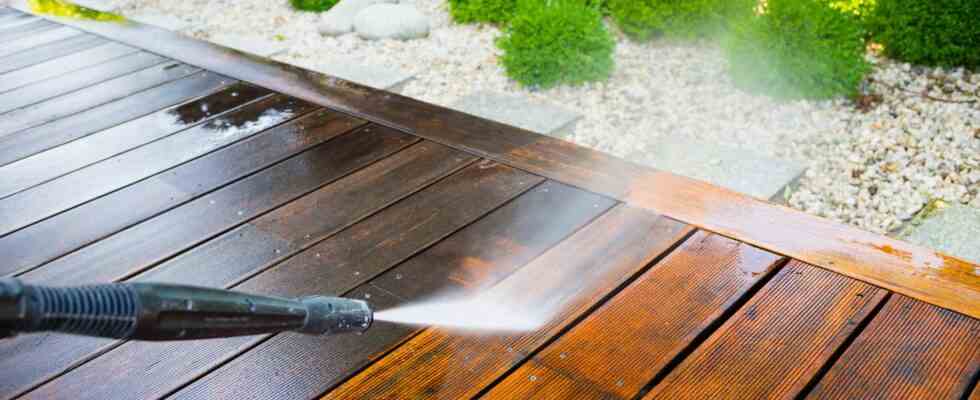Clean thing
Cleaning the terrace: With these tools, you can fight moss and weeds efficiently
water, march! If you want to clean your terrace quickly and thoroughly in spring, you should use a high-pressure cleaner.
© Wojciech Kozielczyk / Getty Images
A dirty terrace not only looks shabby, the greasy surface can also be dangerous. Cleaning is therefore part of the big spring cleaning. These tools are the best way to combat moss and co.
Terraces don’t have it easy. In autumn and winter in particular, they are exposed to all kinds of unpredictable weather around the clock. Wooden terraces in particular suffer from this and often do not look particularly inviting in spring. In the following article you will find out how to clean the terrace – whether it is paved or made of wood – free it of bird droppings in no time at all and make it fit for the summer at high pressure.
Cleaning the terrace: It’s fastest with high pressure
With wooden terraces that have not been subjected to spring cleaning for a long time, you lose one high pressure cleaner not around. Within a few weeks and months, a thin but stubborn layer of dirt often settles on the wooden planks, which water and cleaning rags can hardly get at. Important: Soft types of wood such as western red cedar or Douglas fir should be spared as much as possible from the hard jets of water from a high-pressure cleaner. The proven one is sufficient here mopsome dish soap and some water from the garden hose. So that the weather does not eat into the wood in the first place, it is worth cleaning terraces made of soft wood in this way twice a year. For harder types of wood, the high-pressure cleaner ( here’s the Bosch EasyAquatek) unrivalled. But the following applies here: The greater the water pressure with which you work the wood, the deeper the water penetrates into the natural material. It then takes a correspondingly long time for the wooden planks to dry completely again. This is especially important if you want to give the terrace a protective wood stain afterwards.
A little less caution is required with paved terraces. It is best to remove annoying weeds that have spread in the joints over the summer by hand in autumn. If you don’t want to or don’t have time to get your hands dirty, you can go to one grout brush or one electric grout cleaner to grab. Also effective: a scarfing device. The high-pressure cleaner then takes care of the rest in the spring. Tip: It may be faster with the water jet, but it will be more thorough if you remove dirt and stubborn moss with a root brush and special stone cleaner to edit. In this case, it is essential to clarify beforehand whether the cleaner is suitable for your patio tiles. Some natural stone coverings may react sensitively to the well-intentioned care treatment.
And something else is important for patios made of natural stone: excessive water pressure roughens the surface of the stones. This makes the plates more sensitive to dirt. The dirt can penetrate deeper into the pores and the jointing can also be damaged. With natural stone terraces, you should therefore rely on moderate water pressure, otherwise the cleaning action will backfire. Tip: Attachments with rotating brushes protect sensitive terrace slabs because they reduce the water pressure. The brush heads for high pressure cleaner also help loosen the dirt.
a current one Pressure washer comparison is here.
Danger: Acidic cleaning agents should, if at all, only be used in very small doses to clean the terrace. Because popular home remedies such as vinegar or citric acid not only loosen the dirt, but also flush the limescale out of the stones. If the terrace is very dirty, the stones should be soaked in a biodegradable cleaning solution for several hours and then cleaned with a brush.
You might also be interested in:
This article contains so-called affiliate links. Further information are available here.

